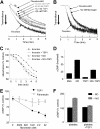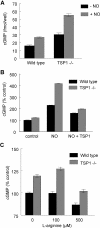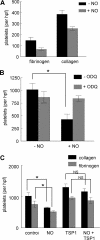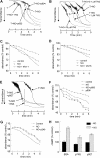Thrombospondin-1 stimulates platelet aggregation by blocking the antithrombotic activity of nitric oxide/cGMP signaling
- PMID: 17890448
- PMCID: PMC2200855
- DOI: 10.1182/blood-2007-06-098392
Thrombospondin-1 stimulates platelet aggregation by blocking the antithrombotic activity of nitric oxide/cGMP signaling
Abstract
Platelet alpha-granules constitute the major rapidly releasable reservoir of thrombospondin-1 in higher animals. Although some fragments and peptides derived from thrombospondin-1 stimulate or inhibit platelet aggregation, its physiologic function in platelets has remained elusive. We now show that endogenous thrombospondin-1 is necessary for platelet aggregation in vitro in the presence of physiologic levels of nitric oxide (NO). Exogenous NO or elevation of cGMP delays thrombin-induced platelet aggregation under high shear and static conditions, and exogenous thrombospondin-1 reverses this delay. Thrombospondin-1-null murine platelets fail to aggregate in response to thrombin in the presence of exogenous NO or 8Br-cGMP. At physiologic concentrations of the NO synthase substrate arginine, thrombospondin-1-null platelets have elevated basal cGMP. Ligation of CD36 or CD47 is sufficient to block NO-induced cGMP accumulation and mimic the effect of thrombospondin-1 on aggregation. Exogenous thrombospondin-1 also reverses the suppression by NO of alphaIIb/beta3 integrin-mediated platelet adhesion on immobilized fibrinogen, mediated in part by increased GTP loading of Rap1. Thrombospondin-1 also inhibits cGMP-mediated activation of cGMP-dependent protein kinase and thereby prevents phosphorylation of VASP. Thus, release of thrombospondin-1 from alpha-granules during activation provides positive feedback to promote efficient platelet aggregation and adhesion by overcoming the antithrombotic activity of physiologic NO.
Figures








Similar articles
-
CD47 is necessary for inhibition of nitric oxide-stimulated vascular cell responses by thrombospondin-1.J Biol Chem. 2006 Sep 8;281(36):26069-80. doi: 10.1074/jbc.M605040200. Epub 2006 Jul 11. J Biol Chem. 2006. PMID: 16835222
-
Blockade of the purinergic P2Y12 receptor greatly increases the platelet inhibitory actions of nitric oxide.Proc Natl Acad Sci U S A. 2013 Sep 24;110(39):15782-7. doi: 10.1073/pnas.1218880110. Epub 2013 Sep 3. Proc Natl Acad Sci U S A. 2013. PMID: 24003163 Free PMC article.
-
Towards the Therapeutic Use of Thrombospondin 1/CD47 Targeting TAX2 Peptide as an Antithrombotic Agent.Arterioscler Thromb Vasc Biol. 2021 Jan;41(1):e1-e17. doi: 10.1161/ATVBAHA.120.314571. Epub 2020 Nov 24. Arterioscler Thromb Vasc Biol. 2021. PMID: 33232198
-
cGMP and cGMP-dependent protein kinase in platelets and blood cells.Handb Exp Pharmacol. 2009;(191):533-48. doi: 10.1007/978-3-540-68964-5_23. Handb Exp Pharmacol. 2009. PMID: 19089344 Review.
-
Thrombospondin-1: a physiological regulator of nitric oxide signaling.Cell Mol Life Sci. 2008 Mar;65(5):728-42. doi: 10.1007/s00018-007-7488-x. Cell Mol Life Sci. 2008. PMID: 18193160 Free PMC article. Review.
Cited by
-
Macromolecular crowding in human tenocyte and skin fibroblast cultures: A comparative analysis.Mater Today Bio. 2024 Jan 28;25:100977. doi: 10.1016/j.mtbio.2024.100977. eCollection 2024 Apr. Mater Today Bio. 2024. PMID: 38322661 Free PMC article.
-
Platelet hyperaggregability in patients with atrial fibrillation. Evidence of a background proinflammatory milieu.Herz. 2016 Feb;41(1):57-62. doi: 10.1007/s00059-015-4335-y. Epub 2015 Jul 2. Herz. 2016. PMID: 26135468
-
Exploring the potential of the platelet membrane proteome as a source of peripheral biomarkers for Alzheimer's disease.Alzheimers Res Ther. 2013 Jun 13;5(3):32. doi: 10.1186/alzrt186. eCollection 2013. Alzheimers Res Ther. 2013. PMID: 23764030 Free PMC article.
-
Effect and mechanism of thrombospondin-1 on the angiogenesis potential in human endothelial progenitor cells: an in vitro study.PLoS One. 2014 Feb 5;9(2):e88213. doi: 10.1371/journal.pone.0088213. eCollection 2014. PLoS One. 2014. PMID: 24505433 Free PMC article.
-
Synthetic gestagens exert differential effects on arterial thrombosis and aortic gene expression in ovariectomized apolipoprotein E-deficient mice.Br J Pharmacol. 2014 Nov;171(22):5032-48. doi: 10.1111/bph.12814. Epub 2014 Sep 5. Br J Pharmacol. 2014. PMID: 24923668 Free PMC article.
References
Publication types
MeSH terms
Substances
Grants and funding
LinkOut - more resources
Full Text Sources
Other Literature Sources
Molecular Biology Databases
Research Materials

